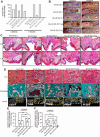Cell-based immunotherapy with mesenchymal stem cells cures bisphosphonate-related osteonecrosis of the jaw-like disease in mice
- PMID: 20200952
- PMCID: PMC3154005
- DOI: 10.1002/jbmr.37
Cell-based immunotherapy with mesenchymal stem cells cures bisphosphonate-related osteonecrosis of the jaw-like disease in mice
Abstract
Patients on high-dose bisphosphonate and immunosuppressive therapy have an increased risk of bisphosphonate-related osteonecrosis of the jaw (BRONJ); despite the disease severity, its pathophysiology remains unknown, and appropriate therapy is not established. Here we have developed a mouse model of BRONJ-like disease that recapitulates major clinical and radiographic manifestations of the human disease, including characteristic features of an open alveolar socket, exposed necrotic bone or sequestra, increased inflammatory infiltrates, osseous sclerosis, and radiopaque alveolar bone. We show that administration of zoledronate, a potent aminobisphosphonate, and dexamethasone, an immunosuppressant drug, causes BRONJ-like disease in mice in part by suppressing the adaptive regulatory T cells, Tregs, and activating the inflammatory T-helper-producing interleukin 17 cells, Th17. Most interestingly, we demonstrate that systemic infusion with mesenchymal stem cells (MSCs) prevents and cures BRONJ-like disease possibly via induction of peripheral tolerance, shown as an inhibition of Th17 and increase in Treg cells. The suppressed Tregs/Th17 ratio in zoledronate- and dexamethasone-treated mice is restored in mice undergoing salvage therapy with Tregs. These findings provide evidence of an immunity-based mechanism of BRONJ-like disease and support the rationale for in vivo immunomodulatory therapy using Tregs or MSCs to treat BRONJ.
2010 American Society for Bone and Mineral Research.
Figures





Similar articles
-
Bisphosphonates cause osteonecrosis of the jaw-like disease in mice.Am J Pathol. 2010 Jul;177(1):280-90. doi: 10.2353/ajpath.2010.090592. Epub 2010 May 14. Am J Pathol. 2010. PMID: 20472893 Free PMC article.
-
Bony changes in the jaws of rats treated with zoledronic acid and dexamethasone before dental extractions mimic bisphosphonate-related osteonecrosis in cancer patients.Oral Oncol. 2009 Feb;45(2):164-72. doi: 10.1016/j.oraloncology.2008.04.013. Epub 2008 Aug 19. Oral Oncol. 2009. PMID: 18715819
-
Multipotent mesenchymal stromal cell sheet therapy for bisphosphonate-related osteonecrosis of the jaw in a rat model.Acta Biomater. 2016 Sep 15;42:400-410. doi: 10.1016/j.actbio.2016.06.022. Epub 2016 Jun 17. Acta Biomater. 2016. PMID: 27326918
-
Bisphosphonate-related osteonecrosis of the jaws: an update on clinical, pathological and management aspects.Head Neck Pathol. 2007 Dec;1(2):132-40. doi: 10.1007/s12105-007-0033-2. Epub 2007 Dec 5. Head Neck Pathol. 2007. PMID: 20614264 Free PMC article. Review.
-
Bisphosphonate-related osteonecrosis of the jaw: an overview.Ann N Y Acad Sci. 2011 Feb;1218:38-46. doi: 10.1111/j.1749-6632.2010.05768.x. Epub 2010 Sep 28. Ann N Y Acad Sci. 2011. PMID: 20946580 Review.
Cited by
-
Small Extracellular Vesicles Derived from Adipose Tissue Prevent Bisphosphonate-Related Osteonecrosis of the Jaw by Promoting Angiogenesis.Int J Nanomedicine. 2021 May 7;16:3161-3172. doi: 10.2147/IJN.S305361. eCollection 2021. Int J Nanomedicine. 2021. PMID: 33994785 Free PMC article.
-
Adipose-derived stem cells prevent the onset of bisphosphonate-related osteonecrosis of the jaw through transforming growth factor β-1-mediated gingival wound healing.Stem Cell Res Ther. 2019 Jun 13;10(1):169. doi: 10.1186/s13287-019-1277-y. Stem Cell Res Ther. 2019. PMID: 31196208 Free PMC article.
-
Comparison of the Effect of Oral Versus Intravenous Bisphosphonate Administration on Osteoclastogenesis in Advanced-Stage Medication-Related Osteonecrosis of the Jaw Patients.J Clin Med. 2021 Jul 4;10(13):2988. doi: 10.3390/jcm10132988. J Clin Med. 2021. PMID: 34279472 Free PMC article.
-
Oestrogen and zoledronic acid driven changes to the bone and immune environments: Potential mechanisms underlying the differential anti-tumour effects of zoledronic acid in pre- and post-menopausal conditions.J Bone Oncol. 2020 Sep 15;25:100317. doi: 10.1016/j.jbo.2020.100317. eCollection 2020 Dec. J Bone Oncol. 2020. PMID: 32995253 Free PMC article. Review.
-
Geranylgeraniol prevents zoledronic acid-mediated reduction of viable mesenchymal stem cells via induction of Rho-dependent YAP activation.R Soc Open Sci. 2021 Jun 9;8(6):202066. doi: 10.1098/rsos.202066. R Soc Open Sci. 2021. PMID: 34113452 Free PMC article.
References
-
- Lipton A. New therapeutic agents for the treatment of bone diseases. Expert Opin Biol Ther. 2006;5:817–832. - PubMed
-
- Berenson JR, Hillner BE, Kyle RA, et al. American Society of Clinical Oncology clinical practice guidelines: the role of bisphosphonates in multiple myeloma. J Clin Oncol. 2002;20:3719–3736. - PubMed
-
- Lipton A, Theriault RL, Hortobagyi GN, et al. Pamidronate prevents skeletal complications and is effective palliative treatment in women with breast carcinoma and osteolytic bone metastases: long-term follow-up of two randomized, placebo-controlled trials. Cancer. 2000;88:1082–1090. - PubMed
-
- Berenson JR, Rosen LS, Howell A, et al. Zoledronic acid reduces skeletal-related events in patients with osteolytic metastases. Cancer. 2001;91:1191–1200. - PubMed
-
- Marx RE. Pamidronate (Aredia) and zoledronate (Zometa) induced avascular necrosis of the jaws: a growing epidemic. J Oral Maxillofac Surg. 2003;61:1115–1117. - PubMed
Publication types
MeSH terms
Substances
Grants and funding
LinkOut - more resources
Full Text Sources
Other Literature Sources
Medical

